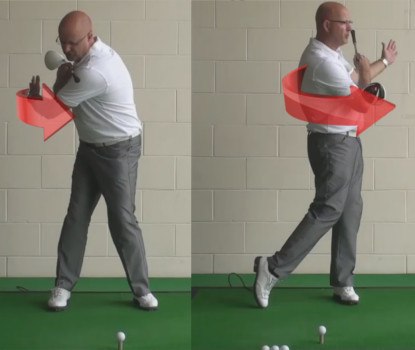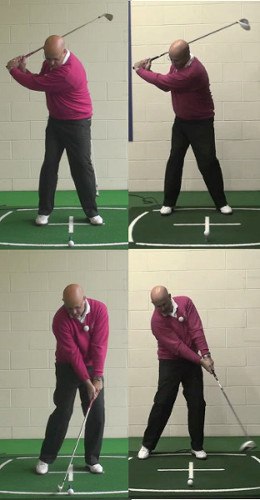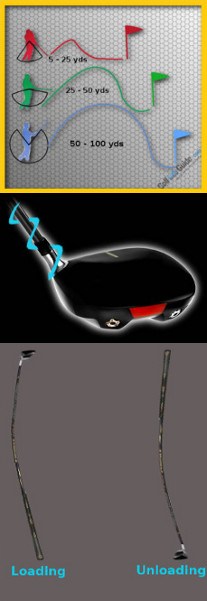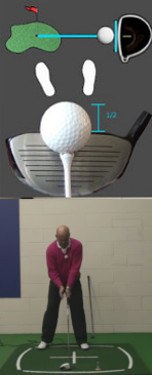
To hit the ball further use this exercise to turn the chest faster rather than hit the ball harder.
To gain more distance from the tee means increasing the speed of the club head through the golf ball. The club swings in a circle around the body and sling shots into the golf ball and it is the turning motion of the shoulders that guides the golf club in this circle. If the golfer can increase the speed of the shoulder rotation in the golf swing, the golfer will gain more speed and therefore more distance.
Generally, golfers do focus on the shoulders to increase power, however, the emphasis should not be on power but the turning motion or rotation of the shoulders. Particularly for those golfers who are not as strong, a 'powerful' shoulder action can cause serious swing problems. A golfer who uses the power of the shoulders generally attacks the golf ball from the top of the golf swing. When this happens, the golf club approaches the golf ball too steeply downwards into the golf ball. The outcome is either that the club head is driven down through the ball into the ground or that the golfer leans back and 'pulls up' out of the shot at the moment of impact. In both situations the power created is not put into the ball but wasted as the ball is not driven forwards towards the target or is simply mis-hit.
Instead of focusing on power, the golfer should focus on a rotational motion in the swing and concentrate on the chest turning through the ball. Turning the chest through the ball towards the target completes the rotation of the body through impact which maximizes speed.
For an exercise to turn the chest through the ball rather than use the shoulders, set up normally and take some practice swings. With each swing, make sure that the chest turns all the way forwards through the ball and faces to the target or, if flexibility allows, slightly to the left of the target (for right handed golfers). For each swing, focus on turning the chest to this position faster which should feel like the arms and club are being dragged through the ball. This is usually a reversal of what happens as the arms are usually 'pushing' the golf club through the ball and so this may feel a little uncontrolled and unsynchronized at first.
Turn the chest faster rather than drive the shoulders into the ball and club head speed will increase along with driving distance.

Longer Drives with Chest Turn Speed
Would you like to hit longer drives? On second thought, don't even bother answering that question – we already know the answer. Every golfer would like to tack at least a few yards onto his or her average drive. After all, hitting longer drives means you will be hitting shorter approach shots, and that is a great recipe for making more birdies. There is far more to golf than just sheer distance, but it sure is nice to be able to smash one right down the middle of the fairway when you really need it.
In this article, we are going to address one specific way in which you can add distance to your drives. Instead of looking at your equipment or even your physical fitness, we are instead going to focus on the rotation of your chest through the shot. By adding speed to the turning action of your chest in the downswing, you can add speed to the club and yards to your drives. Too many amateur golfers think about swinging the club as quickly as possible while forgetting that it is the core of the body which generates all the power. If you can make a powerful move with your chest and the rest of your core, your arms and the club will have no choice but to come along for the ride.
Of course, as you probably know, there are many more elements involved in driving distance than just chest turn speed. You do need to have the right club in your hands, and you need to have the proper golf ball on the tee. Also, you should be in good physical condition, and you should have the rest of your swing mechanics tuned up. By focusing on chest turn in this article, we are not saying those other points are unimportant – they are all important. Your driving distance is an accumulation of all of these various factors. Put them all together in your favor and you will be able to hit the ball impressive distances time after time.
As is always the case when talking about distance, it is important to point out that you should not ruin the rest of your golf swing simply because you are in pursuit of more yards. Distance is far from the most important thing in the game, as you will never be able to play well without control over your ball. Control should always come first, with distance being a secondary consideration. Basically, you want to obtain as much distance as possible without losing the ability to control your shots around the course. There is a fine line to be walked here with regard to this point – find the right balance for you and lower scores will be just around the corner.
All of the content in this article is written from the perspective of a right-handed golfer. If you play golf left-handed, please take a moment to reverse the directions as necessary.

The Speed Chain
From the top of your backswing down to the moment of impact, there is a very specific chain of events which needs to take place in order for you to strike a powerful shot. You can think of this as the 'speed chain', as one element is connected to the other like the links on a chain. If you manage to execute all of these elements in the proper order, and with plenty of speed, you will be left with a powerful strike.
Unfortunately, most amateur golfers make a mess of the speed chain. Millions of players have this chain badly out of order, and the end result is a weak swing which sends the ball nowhere near the target. If you struggle to create as much power as you think you should be able to produce, it is very likely that your speed chain is out of line. Only when you get this part of your game into position will you be able to hit the kinds of drives that you will be proud to watch sail down the fairway.
To help you understand how the speed chain is supposed to work, we have laid out everything that needs to happen from the top of your swing down to the moment of impact.
- The first action you should take in the downswing is turning your hips open toward the target. As soon as the club arrives at the top of the swing, your left hip should be turning aggressively to the left. This is a crucial first move, and yet it is missed by many golfers. The average golfer moves his or her hands down toward the ball before anything else, which is a mistake that makes it hard to get back on track. Forcing your hands down first will ruin the speed chain, and you will struggle to hit drives with any kind of significant power. Before you go any further, make sure this point is crystal clear in your mind – the left hip is the first thing to move in the downswing.
- Now that your hips are on the way, the chain can really get into motion. From your hips, you need to uncoil the rest of your body gradually, working from top to bottom. In other words, your torso is going to follow along with your hips, and pretty soon your shoulders will be in on the action. The biggest key at this point in the swing is to prevent your arms from becoming too involved. You have to be patient and let your body keep turning toward the target. If it feels like your arms and the club are falling behind in the swing, you are on the right track.
- As you keep turning, your arms are eventually going to be pulled into action. When they do start to swing down toward the ball, make sure you allow them to trace a natural path rather than forcing them up and away from your body. Many golfers push their arms out away from their side when the downswing is in motion, and the result is an across-the-line hit and a slice. Keep your right elbow in close to your side and keep your hands quiet for now. It is important that you keep your rotation going toward the target with no feeling of hesitation or indecision. Confidence is a critical part of keeping this chain moving along.
- When your hips have cleared through the ball and your weight has begun to move onto your left side, it will finally be time to let your hands release the club through the hitting area. At this time, your right hand becomes incredibly important. All of the speed which has been built up during the downswing is going to be unleashed with the help of your right hand. As long as you have held on to your lag angle so far in the downswing, there should be plenty of speed waiting to be used. Use your right hand to propel the club head into the back of the ball and send the shot on its way. This is the last step in the chain, and it is when all of your hard work pays off.
When you read through the steps above, it might seem as though it could take a significant amount of time to complete the entire speed chain action on the way down. Of course, that is not the case. You only have a fraction of a second to complete everything above, so it all has to happen 'automatically' when you start down toward the ball. By practicing these moves step by step, you can put yourself in a great position to blast powerful drives hole after hole.
Also, we should point out specifically the role that your chest turn is going to play in this chain. Once your hips set the rotation in motion, you will be able to turn through the ball aggressively with your chest and the rest of your upper body. The more speed you can include in this part of the swing, the more potential for power you will have in place.

Adding Speed to the Motion
One of the hardest things to do in golf is to add speed to your swing. This is a challenge because you are currently comfortable with your present swing, and it will be hard to break out of that pattern. Even if you aren't happy with your results at the moment, you still are comfortable with the swing and human beings have a hard time turning away from comfort. You may need to make yourself a little uncomfortable during practice in order to pick up speed, and doing so is going to take significant commitment to the process as a whole.
So how can you add speed to your chest turn in the downswing? The following tips should put you on the right track.
- Use a wide stance. Placing your feet relatively far apart at address is going to make it easier for you to turn your chest quickly in the downswing. The stability provided by a wide stance is something you simply can't replicate any other way. You need to be stable in the downswing to strike your drives solidly on the middle of the face, so don't overlook the importance of a wide stance. While you can experiment to find a width which is comfortable for you, placing your feet just slightly wider than shoulder width apart is a good place to start.
- Leave your doubts behind. One of the biggest limiting factors when it comes to chest speed in the downswing is simply fear. The fear of hitting a bad shot can slow you down significantly as you swing. Once you pick a target for your shot, you cannot afford to be nervous or afraid of the shot you face – instead, you need to be confident in your abilities and swing with no reservations at all. Sure, you are going to hit some bad shots from time to time, but you are going to hit plenty of good shots as well. You may be amazed to find just how much distance you can gain simply by having a better attitude over the ball.
- Spend more time practicing. Golf, like any other sport, becomes easier as you gain experience. Of course, golf will never be easy, because it is one of the most difficult games in the world. However, if you are willing and able to spend some time on the driving range on a consistent basis, you will find that your swing becomes more natural – and more powerful. Hitting golf balls is a sure way to work out your 'golf muscles', and those muscles will reward you with better and better performance over time.
You will notice that there is nothing complicated about the tips above. In fact, two of those three tips don't even have anything to do with your technique. That's because you don't want to mess with your basic technique just to seek out some extra yards. Sure, it would be great to hit longer drives, but making major changes to do so would just be asking for trouble. Stick with small adjustments and work on adding speed to your chest turn a bit at a time.

The Equipment Factor
It would be a mistake to have an article about driving distance without some mention of the equipment you are using to hit your drives. This is actually related to the top of chest speed, as the driver you use is going to affect how quickly you can turn your chest through the shot. With the right driver in hand, there will be no limitations on what you can do – but the wrong driver is going to hold you back on every single shot.
The most important piece of the equipment puzzle is the shaft you have in your driver. You can think of the shaft as the engine of the club. You obviously want to find a club head that you like, but far more time and attention should be paid to the selection of the right shaft. If you use a shaft which is too stiff, you are going to have a hard time flexing it on the way down, and your shots will lack speed. Or, if the shaft you are using is too soft, the club will flex too much and you won't have any control over your trajectory. It is essential to find a driver shaft which falls in the middle of these two extremes.
In addition to shaft flex, you also need to think about the weight of the shaft. This is where many players go wrong and wind up slowing down their swings as a result. If you use a shaft which is too heavy for your physical capabilities, your rotation will be slowed and you will lose distance. It might not seem like a big deal to use a club which weighs 10 or 15 grams more than it should, but that small variance can make a big impact on how far you hit the ball.
The best way to find the right driver shaft is to work with a fitting professional. A club fitting pro will be able to use a launch monitor to measure all of the various elements of your driver swing. Once that data has been collected, the computer – along with the pro – will be able to recommend a variety of shafts for you to pick from. After a bit of experimenting with those shafts, it should be easy to select a winner. It doesn't cost much to go through a club fitting process at your local golf shop, and many shops will even refund the cost of the fitting if you purchase new equipment from them.
One other important point which needs to be made regarding equipment is the fact that you don't want to be constantly switching gear in search of the right club. It is a good idea to go through a club fitting as soon as possible because you will be able to settle in with a driver for the long haul. If you frequently switch drivers, it will be hard to develop the necessary level of comfort and trust to use that club to the best of its ability. Take some time to find the right club and then stick with it through thick and thin for as long as possible.

Other Distance Tips
Turning your chest quickly through the hitting area is certainly an important part of driving distance. However, there are plenty of other tips to keep in mind while trying to maximize your distance, so we are going to highlight a few of those tips here. If you can integrate these tips into your game along with working on your chest turn speed, the longest drives of your life may be soon to arrive.
- Tee the ball high. Many amateur golfers are afraid to tee the ball high – they think that the club will slide right under the ball at impact – but this is one of the most important things you can do to optimize your distance. When the ball is teed high, you will be able to hit up with an ascending blow, meaning your launch angle will be improved and backspin should be reduced. Because most drivers on the market today include 460cc club heads, you just can't afford to tee the ball low if you want to find the sweet spot. Add some long tees to your bag and tee the ball high anytime you want to launch one into the distance.
- Play the ball forward in your stance. This is another point which will help you achieve an ascending blow. It will be easy to hit up on the ball when you position the ball near your left foot in the stance. Don't slide toward the target as you swing in an effort to reach the ball, however – stay centered and focus on rotation more than anything else.
- Pick your spots. If you are trying to use your driver on a hole which would be better handled with a three wood or long iron off the tee, you are naturally going to make a cautious swing. This carefully about your club selection off the tee and only use your driver when you are sure there is room for it to work. There is nothing wrong with playing shorter clubs off the tee on narrow holes, so always keep an open mind before making your selection and hitting a shot. Your distance will be improved with this line of thinking because you will be able to make a confident, committed swing with whatever club you pick.
- Think about course conditions. If you are playing on a wet course, you will want to maximize your carry distance in order to move the ball as far down the fairway as possible. On the other hand, it is a good idea to keep the ball low for plenty of bounce and roll when the fairways are firm. You can add yards to your average drive simply by making smart decisions with regard to the trajectory you use from the tee.
Everyone loves distance in golf, and adding speed to your chest turn is one way to tack on a few extra yards without making any other radical changes. As you work on speeding up your turn, pay close attention to the rest of your mechanics to make sure nothing is getting off track. It would be a shame to add distance to your drives only to find that you can no longer hit fairways with consistency because something has gone wrong in your mechanics. Long drives are only useful when they are in the short grass, after all. Use the advice provided in this article as you practice and look for signs of improvement along the way. Good luck!






